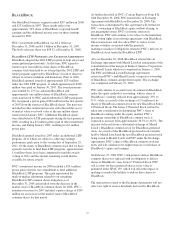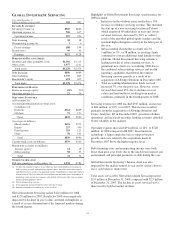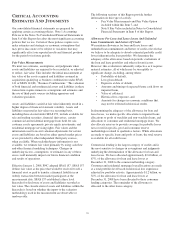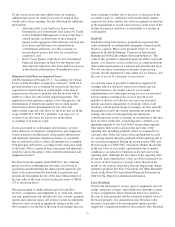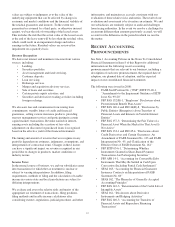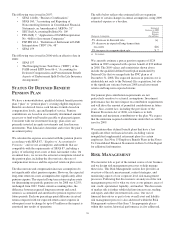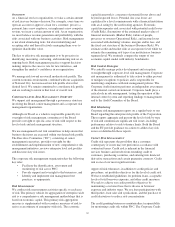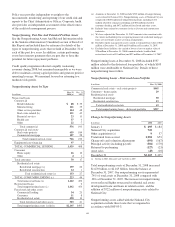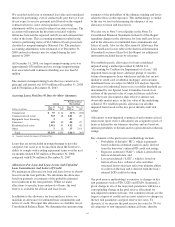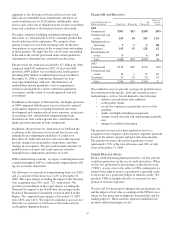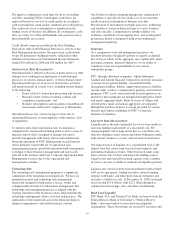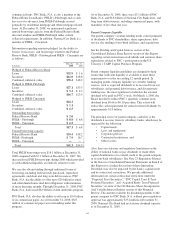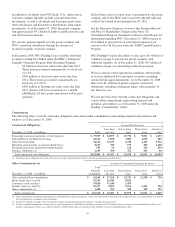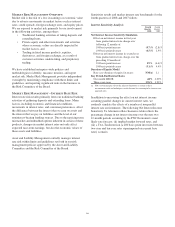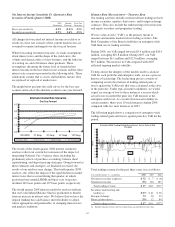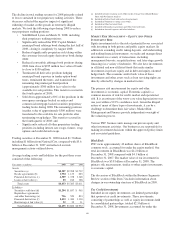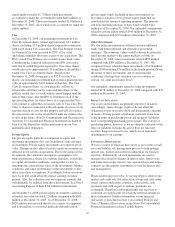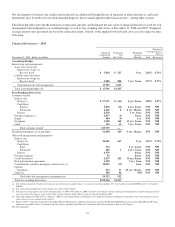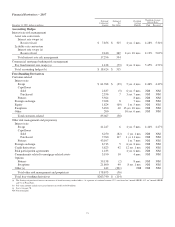PNC Bank 2008 Annual Report Download - page 65
Download and view the complete annual report
Please find page 65 of the 2008 PNC Bank annual report below. You can navigate through the pages in the report by either clicking on the pages listed below, or by using the keyword search tool below to find specific information within the annual report.
We recorded such loans at estimated fair value and considered
them to be performing, even if contractually past due (or if we
do not expect to receive payment in full based on the original
contractual terms), since certain purchase accounting
adjustments will be accreted to interest income over time. The
accretion will represent the discount associated with the
difference between the expected cash flows and estimated fair
value of the loans. This accounting treatment resulted in the
return to performing status of $3.2 billion of loans previously
classified as nonperforming by National City. The purchase
accounting adjustments were estimated as of December 31,
2008 and such estimates may be refined during the first
quarter of 2009.
At December 31, 2008, our largest nonperforming asset was
approximately $36 million and our average nonperforming
loan associated with commercial lending was less than $1
million.
The amount of nonperforming loans that was current as to
principal and interest was $555 million at December 31, 2008
and $178 million at December 31, 2007.
Accruing Loans Past Due 90 Days Or More- Summary
Amount
Percent of Total
Outstandings
Dollars in millions
Dec. 31
2008 (a)
Dec. 31
2007
Dec. 31
2008 (a)
Dec. 31
2007
Commercial $97$14 .14% .05%
Commercial real estate 723 18 2.81 .20
Equipment lease financing 2 .03
Consumer 419 49 .80 .27
Residential real estate 2,011 43 9.32 .45
Other 712 .37 2.91
Total $3,259 $136 1.86% .20%
(a) Amounts include the impact of National City.
Loans that are not included in nonperforming or past due
categories but cause us to be uncertain about the borrower’s
ability to comply with existing repayment terms over the next
six months totaled $745 million at December 31, 2008,
compared with $134 million at December 31, 2007.
Allowances For Loan And Lease Losses And Unfunded
Loan Commitments And Letters Of Credit
We maintain an allowance for loan and lease losses to absorb
losses from the loan portfolio. We determine the allowance
based on quarterly assessments of the probable estimated
losses inherent in the loan portfolio. While we make
allocations to specific loans and pools of loans, the total
reserve is available for all loan and lease losses.
In addition to the allowance for loan and lease losses, we
maintain an allowance for unfunded loan commitments and
letters of credit. We report this allowance as a liability on our
Consolidated Balance Sheet. We determine this amount using
estimates of the probability of the ultimate funding and losses
related to those credit exposures. This methodology is similar
to the one we use for determining the adequacy of our
allowance for loan and lease losses.
We refer you to Note 5 Asset Quality in the Notes To
Consolidated Financial Statements in Item 8 of this Report
regarding changes in the allowance for loan and lease losses
and in the allowance for unfunded loan commitments and
letters of credit. Also see the Allocation Of Allowance For
Loan And Lease Losses table in the Statistical Information
(Unaudited) section of Item 8 of this Report for additional
information included herein by reference.
We establish specific allowances for loans considered
impaired using a method prescribed by SFAS 114,
“Accounting by Creditors for Impairment of a Loan.” All
impaired loans except leases and large groups of smaller-
balance homogeneous loans which may include but are not
limited to credit card, residential mortgage, and consumer
installment loans are subject to SFAS 114 analysis. Specific
allowances for individual loans over a set dollar threshold are
determined by our Special Asset Committee based on an
analysis of the present value of expected future cash flows
from the loans discounted at their effective interest rate,
observable market price, or the fair value of the underlying
collateral. We establish specific allowance on all other
impaired loans based on the loss given default credit risk
rating.
Allocations to non-impaired commercial and commercial real
estate loans (pool reserve allocations) are assigned to pools of
loans as defined by our business structure and are based on
internal probability of default and loss given default credit risk
ratings.
Key elements of the pool reserve methodology include:
• Probability of default (“PD”), which is primarily
based on historical default analyses and is derived
from the borrower’s internal PD credit risk rating;
• Exposure at default (“EAD”), which is derived from
historical default data; and
• Loss given default (“LGD”), which is based on
historical loss data, collateral value and other
structural factors that may affect our ultimate ability
to collect on the loan and is derived from the loan’s
internal LGD credit risk rating.
Our pool reserve methodology is sensitive to changes in key
risk parameters such as PDs, LGDs and EADs. In general, a
given change in any of the major risk parameters will have a
corresponding change in the pool reserve allocations for
non-impaired commercial loans. Our commercial loans are the
largest category of credits and are most sensitive to changes in
the key risk parameters and pool reserve loss rates. To
illustrate, if we increase the pool reserve loss rates by 5% for
all categories of non-impaired commercial loans, then the
61



